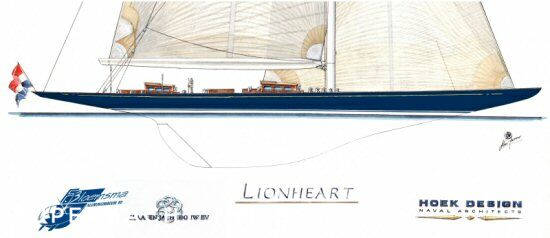Construction is well underway on Lionheart, the first of a new breed of aluminium J-Class yachts from the boards of Hoek Design in the Netherlands. One of the leading offices in classically styled sailing yachts, Hoek Design is intimately involved in the revival of these magnificent yachts from the 1930s. In addition to Lionheart, which will be launched in the third quarter of 2009, the office has three other J-class yachts under development.

Hoek Design has developed specific Velocity Prediction Software for J-Class yachts in partnership with Piet van Oossanen of wing keel fame. This highly sophisticated Velocity Prediction Program (VPP) has been developed specifically for these craft, and was calibrated using tank test data from a six-metre long model of a J. The aerodynamic part was calibrated with wind tunnel test data. “In contrast to other types of software, our VPP software is capable of calculating rudder angles as well as predicting performance in waves,” Andre Hoek explains. “This enables us to also optimise helm balance.”
History makers
One of the key drivers of the J-Class revival was the decision of the J-Class Association to allow aluminium to be used as a hull construction material. This reinforced the renewed interest among owners to build J-class yachts. A total of 20 J’s were designed between 1930 and 1937. Of the ten built in the 1930s, only three have survived: Endeavour, Velsheda and Shamrock V. The Ranger (photo below) that sails today is a replica built to the original lines drawings in steel and launched in 2003. This leaves ten J-Class designs that have never been built.
“Our office carried out a performance analysis of the existing J’s as well as the designs that were allowed to be built under the new J-Class Association rules,” Hoek explains.
“We analysed the line honours and handicap of all 20 yachts and modelled them in our software in such a way that we could predict performance. A specific handicap system was developed by the J-Class Association for these yachts in order to enable smaller and larger and steel and aluminium J’s to race against each other. This analysis gave us a great deal of insight into the performance differences between these yachts.”
“The best five performing yachts were further analysed with computational fluid dynamic software in order to gain greater insight into the differences. The series of yachts originally designed for the Ranger project in 1936 proved to be very good performance-wise, although some are better for light air conditions and others for heavy air.”
Optimising Lionheart
Originally designed for the Ranger syndicate by Starling Burgess and Olin Stephens, Lionheart is the first yacht to be built based upon this research. Under construction for a repeat customer of Hoek Design, she will be the largest J afloat when launched. Tremendous 17-metre overhangs on a LOA of 44 metres have created a fascinating super J with a maximum waterline length.
Hoek: “We extensively optimised Lionheart's structure using 3D structural modelling techniques with finite element software programs. The complete hull structure was analysed for stiffness and torsion, and her stiffness compared to the steel original. The weight of the hull structure was also further optimised, while the hull was developed in high tensile Alustar plating and extrusion materials to provide even greater stiffness. We also carried out extensive research into the mast position, and sail area vs. handicap in order to create a yacht that would perform to her best on the race course.”
The cruising option
Lionheart is designed for cruising as well as racing, and is therefore being built to MCA classification. She will be one of the very few J-Class yachts available for charter as the majority are not built to class. Her deck layout shows two small deckhouses with sleek and low profiles as well as two small cockpit areas.
The privacy concept that Hoek Design created for renowned projects such as Adele, Boreas and the upcoming Athos was also further developed for Lionheart to offer an owner's stateroom with a private deckhouse and private cockpit. Lionheart will also have three guest suites, four crew cabins and a lounge area.
The aluminium hull construction got underway in August 2007 at Freddie Bloemsma’s specialist hull yard and will be finished by Claasen Jachtbouw. Lionheart is the 17th yacht to be built to Hoek Design drawings by Claasen. Construction management is in the hands of Nigel Ingram of Marine Construction Management in Newport, USA.

More J-Class splendour
Hoek Design is also presently working on three other J-Class projects, including a replica of the first J ever built. “Enterprise is the smallest of the fleet but will be a strong contender on handicap,” Hoek says. “She will also be built in Alustar to a high technical specification. Her performance will be extensively optimised and she will be built for both racing and cruising.”
A second project presently under development is a replica of the famous Tore Holm design, Svea. This is under development for a consortium of three Dutch and three Swedish owners who will use the yacht for corporate racing. “Svea’s hull will most probably be built in Holland and the yacht will then be finished at a Swedish yard,” Hoek reveals. “Svea proved to be a strong upwind performer in our tests and is one of the best looking J’s ever designed.”
The third project is a replica of a never built super J by Franck Paine. “This design will be developed along the lines of Lionheart,” Hoek concludes. “She will be another very strong contender in this exciting and expanding fleet of J-Class yachts.”



